Northern White Hybrids Form a New Class of Wine
I was in Arizona years ago attending a wedding and I sought out some local wineries to satisfy my curiosity. It was fascinating seeing vineyards clinging to arid mountainsides, some bordered by impossible looking desert rivers. I recall thinking how different each of these wines would be, each in its own mini-climate.
Alcantara Winery is at the confluence of the Verde River and Oak Creek, Arizona’s only two all year waterways. I tasted their wine overlooking a terraced hillside vineyard above flowing desert waters in an opulent tasting room. It was a great experience.
However, I was disappointed to learn that most of the wine was imported from California and had little to do with Arizona agriculture. Eventually I purchased a bottle of California-grown Chardonnay for $22, far more that I usually pay for wine.
When I got home my son thought it was sound wine; pleasant, lovely oak aroma but unremarkable. ‘$22.00?” he asked, as though I’d gone crazy. He felt it could have been any cookie cutter California Chardonnay, perhaps a box wine like he is accustomed to drinking in the evening. Apparently that tasting room had done its job.
On my way home from Arizona, I decided to get off the freeway and visit one of Nebraska’s scattered prairie wineries. Prairie Vine Vineyards in Mitchell, Nebraska, almost in Wyoming, seemed unlikely enough and I stopped in to see what they were offering.
It was not necessary to ask my usual first question ‘which wines are locally grown” as they all were of little known estate grown hybrids, Elvira, Aurora, Foch, Chelois. What an interesting and obscure selection. I would get to see how Elmer Swenson’s St. Pepin is doing on the great western grasslands.
The St. Pepin was familiar; crisp, fruity, fragrant, fresh and delightful. It had no need of oak, as it had a unique, flowery aroma of its own. I was stunned to realize that this wine was unlike any white I’d found in Arizona. Except in a formal dinner atmosphere with seafood perhaps, it was in every way a better wine. It was nothing like the powerfully alcoholic, heavily oaked Chardonnays everyone has come to expect out of California. This St. Pepin settled upon me like a wine drinking epiphany.
In later days and at other wineries I found Elmer’s rich Brianna, savored the grapey fragrance of Edelweiss and delighted in the University of Minnesota’s aromatic and fruity La Crescent. Unlike a Chenin Blanc, however, or a White Zinfandel or Muscat each was unique and interesting. Eventually I realized we Midwesterners are producing a whole new class of white wines. Our Northern Hybrids are not just bringing grapes to cold regions where they had never prospered before but the climate is giving us a whole new class of wines as well.
Following are descriptions of some of these white Northern Hybrids;
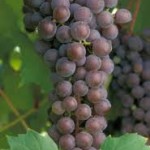 FRONTENAC GRIS – A color mutation of the original Frontenac (red), ‘mother vine”, the MN1047, at the Horticultural Research Center at Excelsior, Minnesota. ‘Gris” is the French word for ‘gray” (pronounced ‘gree”) as it retains some skin color. It produces a somewhat copper, salmon or blush juice depending on the season and the wine is often tinged with salmon or finishes amber. The wine can have a distinctive apricot or peach flavor and is neither a true white or red. This gives it something of an ‘off” reputation although it produces a crisp and delicious, dry varietal and makes a luscious and unique, slightly ‘peachie” dessert wine and has made outstanding ice wines as well.
FRONTENAC GRIS – A color mutation of the original Frontenac (red), ‘mother vine”, the MN1047, at the Horticultural Research Center at Excelsior, Minnesota. ‘Gris” is the French word for ‘gray” (pronounced ‘gree”) as it retains some skin color. It produces a somewhat copper, salmon or blush juice depending on the season and the wine is often tinged with salmon or finishes amber. The wine can have a distinctive apricot or peach flavor and is neither a true white or red. This gives it something of an ‘off” reputation although it produces a crisp and delicious, dry varietal and makes a luscious and unique, slightly ‘peachie” dessert wine and has made outstanding ice wines as well.
To add a note of drama to its history someone actually pruned off and stole the cane that originally exhibited the ‘gris” colored clusters. However, the thief did not take quite enough wood and the damaged cane still grew out the fortuitously mutated wood and this unique material was saved for us all. The culprit on the other hand has never been identified.
See related story: Frontenac Gris Moves Beyond Minnesota
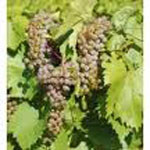 FRONTENAC BLANC – The genetic material of Frontenac is proving to be prone to color mutations and there are spontaneous mutations appearing at various locations around the northland. In fact, one appears to ripen to a lovely gold and another has arisen from a Frontenac Gris vine. The University of Minnesota is reportedly making a collection of them and is finding each clone makes a wine, unique unto itself. The one most commonly available for sale nowadays is from Quebec where it is reported to make a straight forward, neutral, California-style white wine. Winemakers in Quebec have been enthusiastic about the wine and growers there report the fruit ripens about 10 days earlier than the original red.
FRONTENAC BLANC – The genetic material of Frontenac is proving to be prone to color mutations and there are spontaneous mutations appearing at various locations around the northland. In fact, one appears to ripen to a lovely gold and another has arisen from a Frontenac Gris vine. The University of Minnesota is reportedly making a collection of them and is finding each clone makes a wine, unique unto itself. The one most commonly available for sale nowadays is from Quebec where it is reported to make a straight forward, neutral, California-style white wine. Winemakers in Quebec have been enthusiastic about the wine and growers there report the fruit ripens about 10 days earlier than the original red.
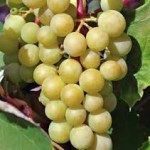 PRAIRIE STAR — This Swenson Hybrid commonly produces a lovely, medium bodied, well balanced white wine. The name is a play on the words of a town near Elmer’s home ‘Star Prairie”. It was selected by two long time growers and winemakers Tom Plocher and Bob Parke who worked closely with Elmer for years and are co-authors of the book Northern Wineworks. Released as a medium bodied, well balanced white, suitable for blending experience has shown that it makes a creditable varietal as well, reminding some of Sauvignon Blanc.
PRAIRIE STAR — This Swenson Hybrid commonly produces a lovely, medium bodied, well balanced white wine. The name is a play on the words of a town near Elmer’s home ‘Star Prairie”. It was selected by two long time growers and winemakers Tom Plocher and Bob Parke who worked closely with Elmer for years and are co-authors of the book Northern Wineworks. Released as a medium bodied, well balanced white, suitable for blending experience has shown that it makes a creditable varietal as well, reminding some of Sauvignon Blanc.
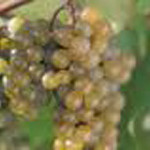 LOUISE SWENSON — This Swenson Hybrid was named for Elmer’s wife and is usually simply called ‘Louise.” It was selected by Tom Plocher and Bob Parke for its excellent disease resistance, hardiness, reliability and excellent wine characteristics. It tends to be slow to establish and come into bearing but often does not need to be sprayed. It produces a slightly honey flavored, very light white wine with a great flowery aroma. However, Louise wines tend to be so light that it is routinely blended with wines like Prairie Star, Lacrosse or Frontenac Blanc for body. It is slow to get sugar above 18% and some winemakers feel if left on the vine it makes a creditable white varietal. It also makes a tasty, handsome, bright seeded table grape.
LOUISE SWENSON — This Swenson Hybrid was named for Elmer’s wife and is usually simply called ‘Louise.” It was selected by Tom Plocher and Bob Parke for its excellent disease resistance, hardiness, reliability and excellent wine characteristics. It tends to be slow to establish and come into bearing but often does not need to be sprayed. It produces a slightly honey flavored, very light white wine with a great flowery aroma. However, Louise wines tend to be so light that it is routinely blended with wines like Prairie Star, Lacrosse or Frontenac Blanc for body. It is slow to get sugar above 18% and some winemakers feel if left on the vine it makes a creditable white varietal. It also makes a tasty, handsome, bright seeded table grape.
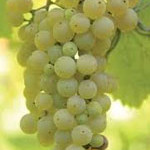 BRIANNA — An Elmer Swenson Hybrid that comes to us via Nebraska where grape grower, breeder and winemaker Ed Swanson selected it as a strong grower and reliable producer. As a white Ed named it Brianna as the female version of Brian which means strong. It ripens in most areas early in September and makes a delicious, fruity and aromatic wine. Since it was selected in Nebraska there was some concern about its hardiness but experience has shown it to be reliable in this regard. In fact anecdotal evidence indicates it is prospering even into Manitoba, fully as strong as Ed predicted. Delicious seeded table grape as well.
BRIANNA — An Elmer Swenson Hybrid that comes to us via Nebraska where grape grower, breeder and winemaker Ed Swanson selected it as a strong grower and reliable producer. As a white Ed named it Brianna as the female version of Brian which means strong. It ripens in most areas early in September and makes a delicious, fruity and aromatic wine. Since it was selected in Nebraska there was some concern about its hardiness but experience has shown it to be reliable in this regard. In fact anecdotal evidence indicates it is prospering even into Manitoba, fully as strong as Ed predicted. Delicious seeded table grape as well.
See related story: Brianna is Midwest’s New Tropical Fruit
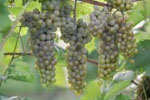 LACRESCENT — A University of Minnesota introduction that makes a delightful and rather complex white wine that is proving to be enormously popular with the public. Characterized by melon, tropical fruit and some say, slight Muscat flavors which is in its background, this wine, when vinted dry, tends to be acetic and harsh with little aroma. When finished sweet, however, Lacrescent becomes, soft and rich, full of fruit flavors and lush fruit aroma. Unfortunately it is very vigorous growing and many growers are struggling with it culturally and have concern that it is not reliable. While it may well make the best of the new kinds of wines coming from the Midwest, until its cultural (?) problems are solved, it may not be with us for long.
LACRESCENT — A University of Minnesota introduction that makes a delightful and rather complex white wine that is proving to be enormously popular with the public. Characterized by melon, tropical fruit and some say, slight Muscat flavors which is in its background, this wine, when vinted dry, tends to be acetic and harsh with little aroma. When finished sweet, however, Lacrescent becomes, soft and rich, full of fruit flavors and lush fruit aroma. Unfortunately it is very vigorous growing and many growers are struggling with it culturally and have concern that it is not reliable. While it may well make the best of the new kinds of wines coming from the Midwest, until its cultural (?) problems are solved, it may not be with us for long.
See related story: La Crescent: A Winemaker’s Grape
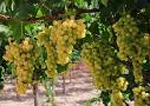 EDELWEISS — Originally selected as the ES#40 this was one of Elmer’s earliest hybrids. Tested in New England by fruit breeder, the late Elwyn Meader. He loved it and marketed it successfully as a table grape ‘White Concord”. Winery owner John Canepa planted it in the White Mountains of New Hampshire and was apparently the first to use it as a wine grape. It was he who named it ‘Edelweiss. It was released through the University of Minnesota without a patent in the 1970s as a table grape.
EDELWEISS — Originally selected as the ES#40 this was one of Elmer’s earliest hybrids. Tested in New England by fruit breeder, the late Elwyn Meader. He loved it and marketed it successfully as a table grape ‘White Concord”. Winery owner John Canepa planted it in the White Mountains of New Hampshire and was apparently the first to use it as a wine grape. It was he who named it ‘Edelweiss. It was released through the University of Minnesota without a patent in the 1970s as a table grape.
It languished in Wisconsin and Minnesota because of marginal hardiness but became established as a wine variety in Nebraska where it has become enormously popular. Liquor stores there report greater demand for Edelweiss wine than for any white to include any California Chardonnay, French Bordeaux or cut-rate Australian white. It is said to be close to that position in Iowa as well. It has won some prestigious ‘Best of show” awards in California and as a result has become an established and even revered wine grape in some areas.
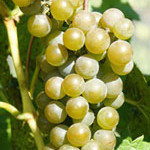 ST. PEPIN — A Swenson Hybrid that makes a delicate and aromatic wine that has become popular with the wine drinking public. Unfortunately to go with its delicate, flowery and feminine character the vine is pistillate and must be planted near other grapes that flower with it or pollination is uncertain and production erratic. Nevertheless it makes a delightful wine with crisp acidity and fresh aroma not requiring oak aging or blending. Winemakers and drinkers have found St. Pepin extremely desirable, unlike anything available from California or elsewhere. It is a wine with great commercial appeal, an excellent example of the new kind of wine only the Midwest can offer.
ST. PEPIN — A Swenson Hybrid that makes a delicate and aromatic wine that has become popular with the wine drinking public. Unfortunately to go with its delicate, flowery and feminine character the vine is pistillate and must be planted near other grapes that flower with it or pollination is uncertain and production erratic. Nevertheless it makes a delightful wine with crisp acidity and fresh aroma not requiring oak aging or blending. Winemakers and drinkers have found St. Pepin extremely desirable, unlike anything available from California or elsewhere. It is a wine with great commercial appeal, an excellent example of the new kind of wine only the Midwest can offer.
These are some of the white wines eastern winemakers can offer. They were developed to make grape growing and wine production feasible in cold climates where wine was not produced in past. Instead these grapes have mated with our climate and given us a class of wines that the public loves and only we can produce.
John Marshall is the owner of Great River Vineyard and Nursery in Lake City, Minnesota. For information see: Great River Vineyard



Great article, John. It’s gratifying to see these U of MN/Swenson varieties being planted so widely, and making tasty wines. I just wish someone here in Ohio would plant some Edelweiss…..it’s one of my favorites. 🙂
Loved your story John and the sharing of your experience during travels. I agree, the cold-hardy white wines are surprisingly good, refreshing and a lovely alternative to the wines of the vinifera world. I love what is happening with the “New American Viticulture”.